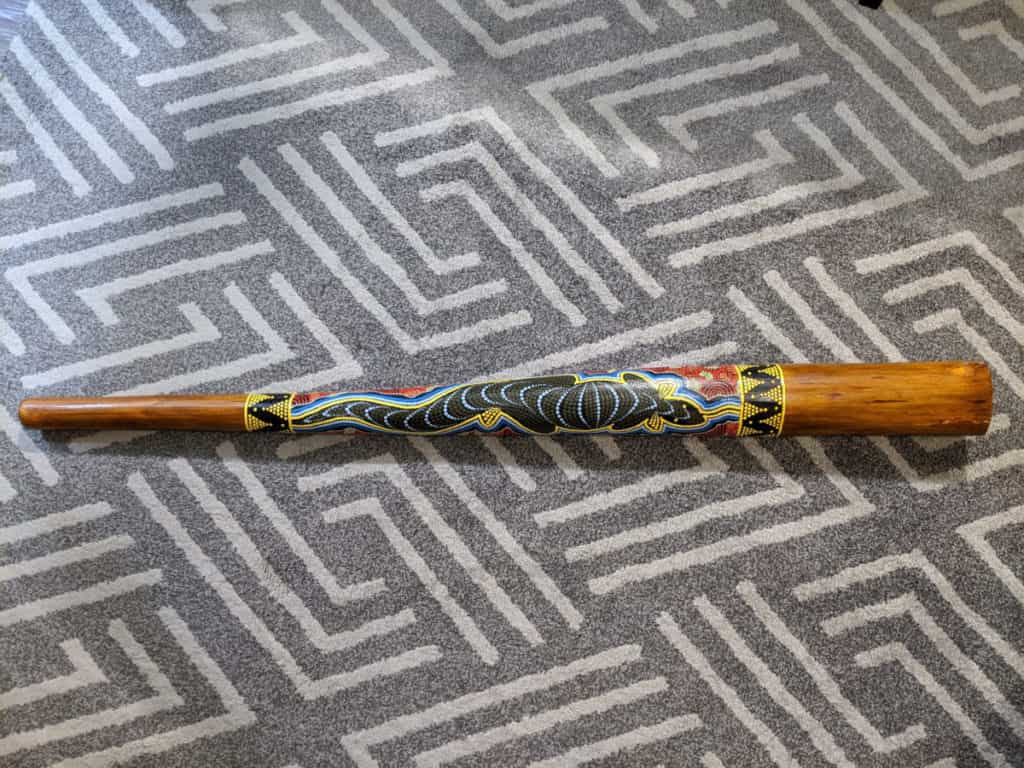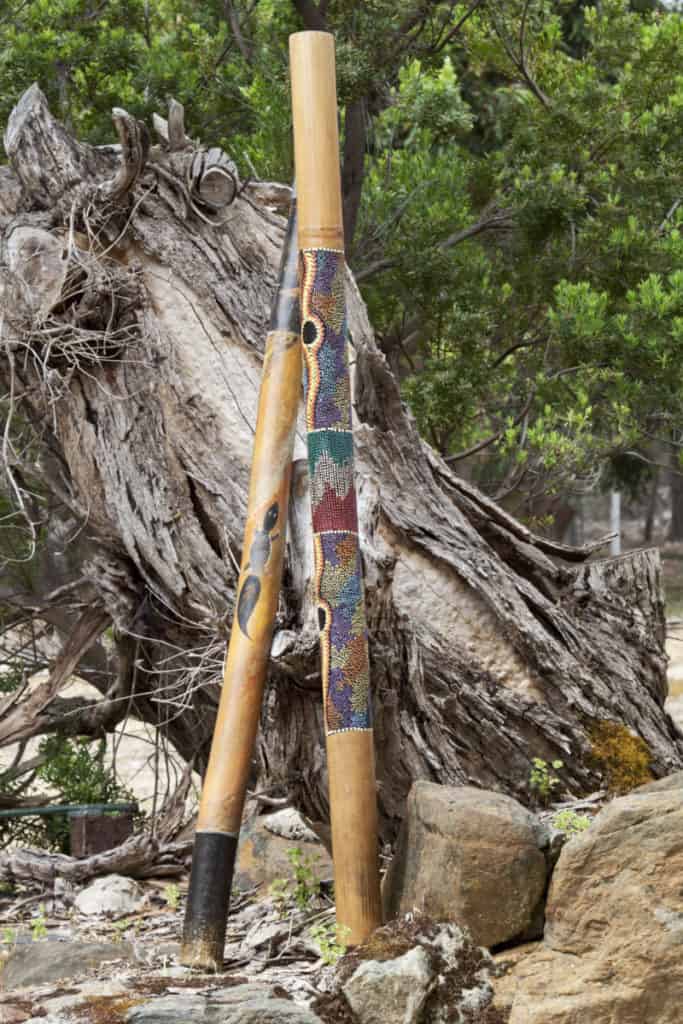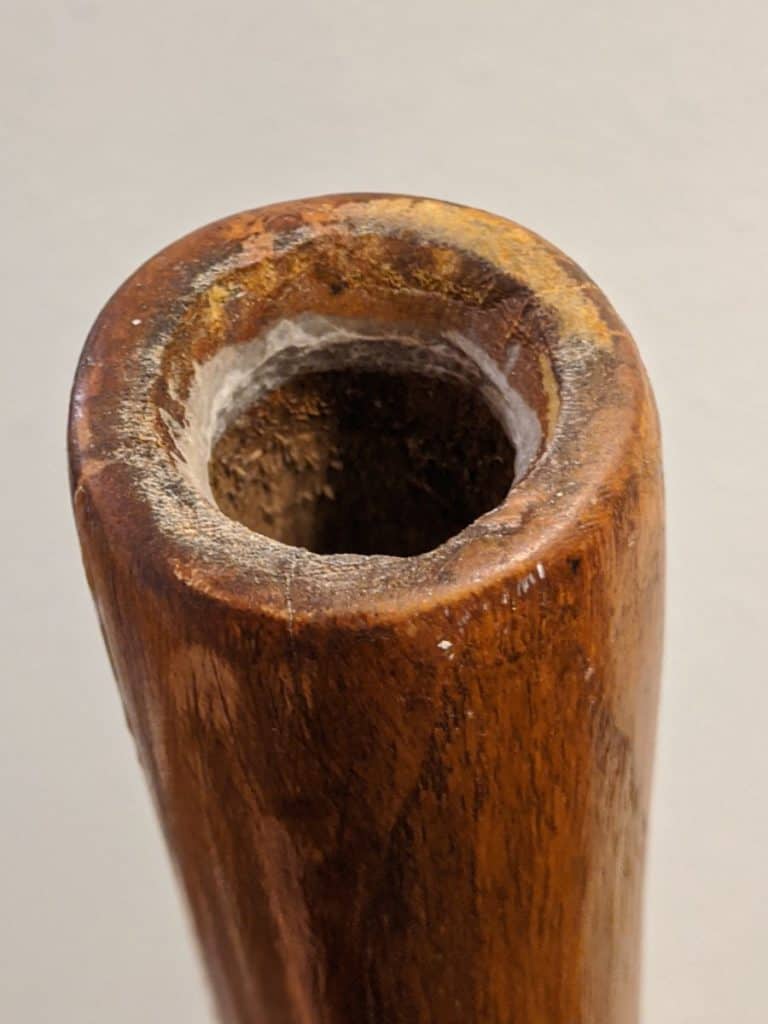This post contains affiliate links. We earn commissions if you purchase products from retailers after clicking on a link from our site. As an Amazon Associate, we earn from qualifying purchases.
What’s super amazing about the didgeridoo is no two didgeridoos (made out of wood at least) are the same, and so it’s difficult to tell you what’s best, however there are definitely things to look for if you’re a beginner to make sure you find a good fit that’s easy to pick up and play.
The key characteristics of a good starting didgeridoo are:
- Easy to Play (properly hollowed)
- Mouthpiece around 30mm (just over an inch) in diameter
- Comfortable Mouthpiece
- A didgeridoo between 3-1/2 and 5 feet long
- No leaks or cracks
- Less then $120
- Conical shape
So what does all that mean? Well, I’m here to help. I have the fortunate privilege of just recently being total beginner, so I just went through this. I know what the experience is like of not knowing how to play and picking up the didgeridoo. By the end of this post you’ll know what you’re looking for and have a great place to start.
What Didgeridoo is Best for Beginners?
If you’re beginning, it’s much more important to find a didgeridoo that’s easy to play so you can get a feel of what’s important to you. For that reason, if I was to do it over again, I would recommend one of Meinl’s PVC Didgeridoos. This is their S-shaped Black design (see price on Amazon), but they have many others.
Why this didge? It’s inexpensive, and it fulfills all of the aspects of a beginner didgeridoo. The didge is perfectly uniform which makes it much easier to play. This means you don’t have to work through any hurdles of the didgeridoo design such as an improperly hollowed-out didge or a didgeridoo with leaks or cracks.
The mouthpiece is uniform and is neither too big or too small (both very important for learning to play)
The Meinl PVC didgeridoos are also conically-shaped but flare out at the end, which gives you more back pressure. We’ll talk about back pressure in a few, but it means essentially that it’s easier to play.
Best Cheap Didgeridoo
The Meinl PVC didgeridoo will not set you back very far, but if you’re still unsure about whether you want to get into playing the didgeridoo and you want to find an even less expensive solution, you can’t do much better than driving to Lowe’s or Home Depot and buying a PVC pipe.
The diameter you are looking for is around 1-1/4 inches. You might get some looks at the hardware store, but try putting your mouth to the pipe and finding a good fit. Remember, no less than an inch in diameter, and no more than 1-3/8 inches.
Furthermore, you will want to cut a length anywhere from 3-1/2 feet to 5 feet long. Start longer because there’s no going back after a cut.
No PVC pipe is going to be comfortable to play initially, fortunately, you made this didgeridoo! So you can improve it. you can sand the sharp edges of the didgeridoo end to smooth it out so it’s more comfortable to play with. You can also use electrical tape around the circumference of the end of the pipe to make a sort of soft mouthpiece if it’s still uncomfortable.
Tape and facial hair don’t play well together, so be careful in this maneuver.
You could definitely use strips of grip-tape used for tennis rackets as those won’t leave the same residue that electrical tape will. You may need to add some of your own adhesive (super glue will be more than enough to get the grip-tape to stick)
Is that good enough? Can you really get by with a PVC pipe?
Absolutely! Remember, in concept, a didgeridoo is simply a hollowed-out log. In other words, a pipe! When you’re a beginner, you don’t need a didgeridoo with the finest sound because you’re still learning how to play and if you want to pursue the instrument. Your sound quality won’t be amazing, but you’ll be able to make all the sounds a regular didgeridoo can make so it’s an excellent choice to get started with.
What Makes a Didgeridoo Easy to Play?
There are many different factors that make a didgeridoo easy to play. I can’t really stress enough how important it is to find a didgeridoo that’s easy to play as your first didgeridoo–it’s always difficult to learn to play a new instrument, and so learning with an instrument that is easier to play will pave the path for you to move on to other better didgeridoos in the future.
I’m going to be using the term: back pressure a lot. If you don’t know that is or if you don’t know why it matters for the didgeridoo, check out my definition of it below.
There are a lot of inexpensive didgeridoos out there, but not all of them are easy to play… let’s look at what didgeridoos are:
Conical-Shaped
Conical-shaped didgeridoos have a thinner bore on one end while the other end flares out, like the shape of a cone. I’ll show you what I mean
This is a picture of my didgeridoo. You can see that it is not a straight cylinder, but instead it is tapered on the left side.

By the way, looking for recording equipment and musical instruments? Check out Sweetwater.com for microphones, monitors, audio interface or any other recording gear that you could ever need. (Affiliate Link)
Conical-shaped didgeridoos have more back pressure, making them easier to play.
Here is an example of a cylindrical didgeridoo that I was able to find:

Notice how both ends of the didgeridoo are the same thickness. While this definitely can work, it will be more difficult to play and learn tricky concepts such as circular breathing.
Bamboo didgeridoos fall into the cylindrical category.
No Leaks Or Cracks
Leaks or cracks in the didgeridoo make a huge difference in back pressure (see below definition). With air escaping it means less pressure, which means it’s more difficult to sustain a drone and perform circular breathing.
If you don’t know what all those sounds are, they are some fundamental skills and concepts for learning the didgeridoo. While still possible, it will just be more difficult.
How Do You Find Leaks or Cracks?
It helps to wear shorts–but if you are able to handle the didgeridoo, you can blow through it and rotate the didgeridoo and try and feel any air escaping from the sides of the didgeridoo.
You can also examine the didgeridoo from all sides and you might be able to see cracks in the outside wood, itself.
Do All Didgeridoos Crack?
Nothing is indestructible. While PVC is known for its strength, it definitely can crack and shatter if it receives any strong shocks.
Wood is by nature porous, and since you are using your mouth to play the instrument, it only makes sense that it will absorb some of the water and expand, and then contract again.
While all didgeridoos can crack, if your didgeridoo is quality-made then it will be cured–which can take several months for the wood to completely dry out. There are all sorts of treatments, including fire–some even will seal the wood with a wood sealer (such as PVA). The key is to ensure the wood is completely dry before attempting an operation like this.
Proper Length of Didgeridoo
As I’ve mentioned, there are thousands of types of didgeridoos out there–every one is different! There are some designs that are more difficult to play and have a different sound.
Some didgeridoos are wrapped in spiral, while others are in the shape of a box with a maze inside that has the same length as a regular didgeridoo. There are some that are shaped more like the shell of a tortoise, and there are still others. They all follow the same basic concept but they all have different a personality and a different sound.
I won’t say that one design is better than the other, but a more traditional style of didgeridoo is a great starting point. At the very least, your curiosity will be piqued and you’ll be left wanting to try every didgeridoo you ever see (at least that’s what has happened to me).
For that reason, I recommend getting a traditionally shaped didgeridoo. Make sure you don’t get one that is too short. You really should get one that is from 3.5 feet to 5 feet long. Any shorter than that and you won’t be able to make some sounds as easily and you lose some of that back pressure that makes playing easier.
Mouthpiece Size (Critically Important)
I can’t understate this point–make sure you get the right size of mouthpiece. Probably more than anything else, the mouthpiece size will dictate how difficult your didgeridoo will be to play.
The mouthpiece is simply the end of the didge that you will be buzzing your lips into. You may have noticed a few different types of mouthpieces.
My didgeridoo, like many others, has a “hard-top” mouthpiece. This means that instead of a formed mouthpiece, the wood is small enough to be played without any additional help.

The other types of mouthpieces can be formed from several different materials, but a common thing you’ll see are mouthpieces made from beeswax–it is not necessary to use a beeswax mouthpiece. I am saying that because I thought that was the case for a while.
Whichever you have, the key is that the didgeridoo mouthpiece hole must be at least an inch across, or a maximum of 1-3/4 inches. Around 30mm (for you metric system fans out there) is a good width to shoot for.
If the mouthpiece is too large, you’re not going to be able to make a seal making it very difficult to play. You can use beeswax (or any type of wax, really–beeswax is favored for many reasons) to make your mouthpiece hole a bit smaller.
Check out this video for a quick demonstration of applying a beeswax mouthpiece to a didgeridoo.:
Note, note all didgeridoos require a mouthpiece! It’s completely okay to not have one if your mouthpiece hole is the appropriate size and it’s tapered so it’s comfortable to play.
What is Back Pressure and Why Is it Important for Beginner Didgeridoo Players?
So… I confess, I’m not a physicist. From my basic understanding, though, back pressure is the phenomenon of pressure that resists the flow of a fluid.
So, it’s the pressure that’s pushing back on your mouth while you’re playing the didgeridoo.
Okay, cool… but who cares?
It’s kind of hard to describe, but I’ll try thought exercise.
Let’s say you are in a straw-blowing competition. You have a straw from your favorite fast-food restaurant… let’s say it’s Chick-fil-A. And your friend has challenged you to a competition to see who can blow through the straw as long as possible.
Imagine that straw now had a leak in it… this means it’s more difficult to keep a focused stream of air. There is less resistance to blow through the straw, making it harder to keep your air flow tiny and constant. Your friend is going to win.
This exact same principle is true for the didgeridoo.
If the bore of the didgeridoo is too wide, or if the didgeridoo is not conical but is cylindrical instead, then there is less back pressure, making these didgeridoos more difficult to play.
Why? Because, similarly like the straw-blowing content, you are trying to keep a constant stream of air pushing through the didgeridoo. If there is no resistance, then you’re just breathing out and it’s much more difficult to play long drones with techniques like circular breathing.
TL;DR: Beginner didgeridoo players should look for conical didgeridoos because they have higher back pressure, and it’s critically important to make sure you don’t have any leaks or cracks.
How to Get Started With the Didgeridoo
Recently I spent 30 days trying to learn the didgeridoo for an hour a day, and in that month I made tremendous progress.
Part of that progress I owe to many others. I learned a lot from several YouTubers, but in this I made a big mistake.
Fortunately, I course corrected and fixed this mistake about a week into this month of learning the didgeridoo.
Why was this difficult? If you’d like to learn more about the challenges of learning the didgeridoo and why it can be very difficult for many people, check out my post here that talks about why and how to overcome that.
So, what’s the secret to learning?
Finding a teacher
Okay, so you might be feeling “I don’t have time to find a teacher!” Hear me out–you’re probably right! However, there are different types of teachers out there that are easier to use than others.
YouTube and random blogs like this one are great for picking up specific aspects of the didgeridoo, however, if you are just starting then what you need is step-by-step instructions to learn the didgeridoo. It’s easy to get bad habits or not learn proper technique if you skip a step or two.
What I’m getting as is if you are just starting, I highly, highly, highly recommend going through a course, or a book.
With a video or audio course, or a book, you’re getting the awesome opportunity to be walked through the process of learning the didgeridoo just like you would if you had a teacher.
I had a great experience learning with Jonny Cope, who has this course on Udemy.
Jonny does a fantastic job of taking you through the very basics of learning the didgeridoo, from choosing the didgeridoo, to posture, to circular breathing techniques (the skill of being able to breathe out stored air from your cheeks while breathing in through your nose at the same time), to how to practice, and how to make all the sounds possible with the didgeridoo.
He has three courses split up, and they are all good–I’d say they are good especially good for beginner players, but he’s got a lot that can help intermediate players, too.
This was the best decision I could make learning the didgeridoo because now I had structure. I had a teacher (albeit virtually) that could walk me through the process of learning. I was able to unlearn any bad habits I was picking up and focus on good technique. It was much less frustrating and much more satisfying to learn like this.
So, bottom line. Don’t just watch YouTube videos (they’re good, but you need something more), instead find a book or a learning course.
Brief Homage to the Australian Aborigines
The Didgeridoo, or its real name the Yidaki is a beautiful instrument that is sacred to the aborigines. The world appreciates the incredible contribution of such an instrument. We don’t necessarily deserve it but we are grateful.
If you haven’t started playing the didgeridoo, it’s a soulful experience–it’s amazingly expressive and it’s easy to get lost in playing. So–thank you.
